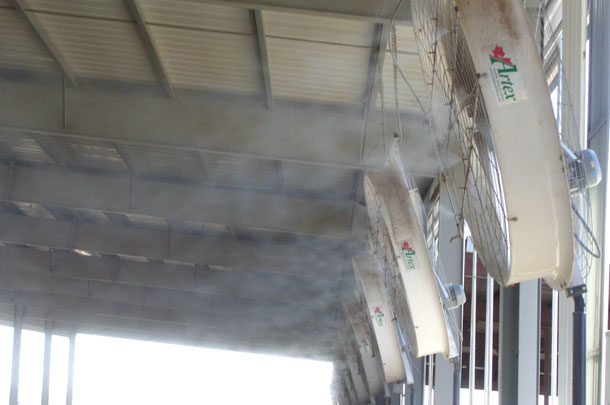High-pressure fogging (HPF) systems are not new to the dairy industry, but there are a lot of misconceptions and a lack of information when it comes to the proper application.
While these systems can be an amazing tool for cooling your cows, improperly done, they can cause headaches and lead to both health issues and equipment damage in your barn.
Let’s figure out if high-pressure fogging could be right for your farm.
What is high-pressure fogging?
High pressure, or water pressurized to 800 psi or greater, allows for the use of smaller orifice nozzles, which by default create a smaller water particulate size to facilitate instant evaporation. The evaporation process of changing the water liquid into water vapor absorbs heat from the air, creating a cooling effect.
Within this detail, there are a couple key things you need to know:
1. 800 psi is the minimum for this instant vaporization
Below that threshold, there will be vaporization, but there will also be dripping, and moisture droplets carried with the air. This creates moisture in beds and on equipment, both negatives in a barn environment.
2. Size matters with your nozzles
The orifice size of the nozzle has to be matched to the pressure used. Too big of a nozzle for the pressure sprays a mist. Too small of a nozzle, and the pressure has to increase to activate it. Typical nozzle sizes for HPF are 0.006 to 0.008 gallon per minute (gpm).
3. Liquid into vapor? Absorbs heat? What is this magic you speak of?
Any time matter changes state (solid, liquid, gas), it absorbs thermal energy. In the case of water changing to gas, it absorbs heat. The correct amount of water used for the volume of air in your barn will affect the microclimate of your facility, effectively lowering the temperature (yes, it will also raise the humidity – more to come).
Real-world applications
Sounds complicated. Why not just use low-pressure water and put it in front of a fan to evaporate and cool the cows? Same thing, right? Unfortunately, no. You are still dealing with larger droplets, so outside of desert heat and humidity conditions, the majority of droplets will just carry in the air. This does not absorb heat, and although to us humans the water will feel cool, there is a risk these droplets will create a moisture coating on the hair of your cows and create an insulative layer, actually warming your cows. Not to mention those water droplets on bedding, activating microbes, and on steel equipment, leading to deterioration and rust. These things are bad.
Ok, so I live in the Midwest; I’d like to cool my cows better on the 90°F days when its 65% humidity, sign me up.
So here’s the catch. We can’t pump more water into the air than it will hold. This is on the curve of both humidity and temperature. The higher the temperature, the more water the air will hold. The higher the humidity, the less evaporation will occur regardless of pressure. Let’s take an example barn: a cross-ventilated barn, 250-by-700 feet and 3.7 million cubic feet of airspace within the barn. For simplicity, we have enough fans in the barn to change the air out every minute. (We can’t let the humidity accumulate, can we?) Volume of air is part of what we need to know to determine how much water.
So let’s take this barn in Wisconsin in July on a 90ºF day when its 65% humidity (temperature-humidity index [THI] 84). The closer air gets to its saturation point, the more difficult it is to get the water to evaporate. As a rule, we target 70% as max target humidity, as beyond this there is diminishing returns with the unevaporated water. So using 14 gpm, we increase the humidity from 65% to 70%, and we reduce the temperature from 90ºF to 88ºF, which has a THI of 83. While there is some change, the change is incremental. How many days do you have conditions like this? Do you have high-producing cows where you need additional tools to achieve the next level of gains?
Let’s take the same barn and plop it in Idaho on a 90ºF day at 15% humidity (THI 75). Using 167 gpm, we take the humidity from 15% to 70% and drop the temperature from 90ºF to 67 (THI 65). This is real change that your cows can appreciate. Maybe happy cows live in Idaho? Depending on your production goals, this is a tool that can get you wide-scale cooling on your hot days and get you a relatively quick return on investment (ROI).
Just to throw you for a loop, let’s plop that same barn in Florida. It’s a 94ºF day, the 110th day above 90ºF in a row. As the temperature rises during the day, the midday humidity hits a low of 55%. (As temperature rises, the water-holding capacity of the air also rises, decreasing relative humidity.) So the cows are sitting at THI 85. Using 40 gpm, we reduce the air temperature to 88ºF and increase the humidity to 70% once again, leaving you with a THI of 83. Not as much gain as Idaho, but did I mention it was the 110th day in a row these cows have felt this heat? Combine this cooling effect with a 6 to 8-mph windspeed, and you are providing these cows with significant relief.
Ok, so enough with the chit-chat, how do I know if I should consider investing in HPF for my farm?
If you are in a high-temperature or moderate-temperature, high-humidity climate, you should consider HPF if:
- Other methods of cow cooling, such as feedlane soaking, will not work for you due to water or water storage constraints.
- You already have a cow cooling strategy and are looking for the next tool to allow you some gains.
- Your ventilation strategy is already providing cow-cooling windspeeds (6-plus mph), and you are effectively changing out the air in your barn 40-60 times per hour.
- You are willing to do the maintenance that an intensive system like this requires.
If in a high-temperature or moderate-temperature climate with low humidity, consider HPF if:
- You have a ventilation strategy that effectively changes out the air from your barn 40-60 times per hour.
- You have limited water storage capacity but available water to use.
- You like the idea of making more milk with your cows.
Now get to it, and make plans for next summer’s heat abatement strategy. Be sure to align with a professional firm to size the system in accordance with your climate and facility.








